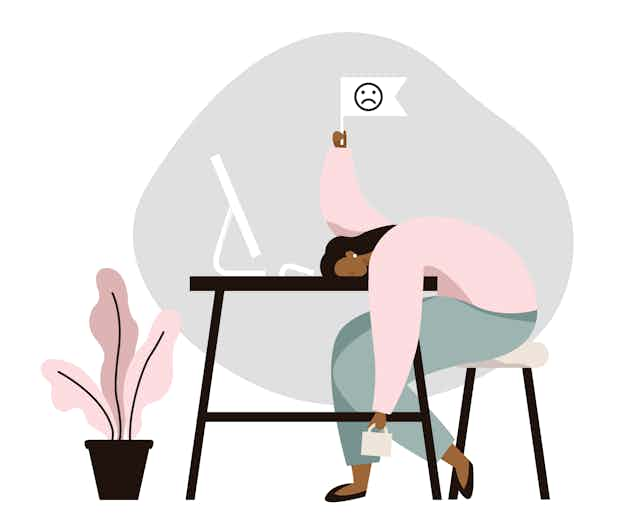Over the past year, our lives have seen extensive changes which have led to many of us feeling a sense of exhaustion and burnout.
The luckiest among us have been able to remove ourselves from harm’s way and work from home during the pandemic. We now spend our days looking at a screen, with a great deal of our communication taking place via video calls. This has led to what has been termed “zoom fatigue”, where our brains are exhausted from overstimulation.
Aside from the eye strain of looking at a screen all day (if we are not looking at a computer, we’re often looking at our TV or our phone), our sense of space is disrupted by video meetings. Suddenly, everyone is much closer than they would be in a pre-pandemic meeting.
In the 1960s, the anthropologist Edward Hall described how our relationships operate within socially accepted distances. Close family and intimate relationships occur within a proximity of half a metre. For close friends, this distance extends to about 1.2 metres.
The pandemic is sending our brain conflicting messages. With video calls, faces are within 50 centimetres of us, and this tells our brain that these are close or intimate friends when instead they are colleagues or strangers. Similarly, social distancing rules have forced our loved ones out into a much more distant field that is usually reserved for people we may meet or know socially, but not very well – acquaintances rather than friends.
While our rational brain understands social distancing, the physical inability to touch and hold our close friends and family can confuse us into thinking the distance is somehow a rejection. The cognitive effort of managing these conflicting messages is tiring.

Video calls also force us to look at ourselves more than we are used to doing, and this can feel uncomfortable and make us worry excessively about how others perceive us.
But turning the video off while on a call can increase burnout in other ways – people may use the opportunity to check emails or catch up on other work while listening in. This multitasking is mentally draining.
We are much more efficient when we work on one task at a time. Our brains respond to the end of one activity and the onset of a new activity from pre-learned cues. Often these cues involve physical movement.
These have largely disappeared – the daily commute is the most obvious absence for those working from home, but walking to and from meetings also allows the brain and body time to prepare for the next task. Outside of work, doing the school run, going to the gym and regular appointments all add structure and separation of space to our lives.
Read more of our coverage of the first anniversary of the pandemic:
Coronavirus one year on: two countries that got it right, and three that got it wrong
Pandemic babies: how COVID-19 has affected child development
The blurring of home and work is not only due to bringing our work into our homes, but also the longer hours people report working. Being unable or unmotivated to take part in our usual activities means the weeks and weekends have begun to morph in to unboundaried time, and the shorter days of winter lessen the distinction between day and night.
How to get through
So how can we address this feeling of burnout and exhaustion?
Build time into your working day for casual chat that is not work-related. Daily conversations range from small talk about the weather, to more substantive conversation about our lives.
Make time for these conversations, maybe arrange an online lunch. The different use of the technology will help to break the monotony and association of screens with burnout. Additionally, sharing the space with colleagues you are friendlier with in real life and who fall in to our personal space allowance, makes the online encounter less stressful.
The charity Fight for Sight suggests a 20-20-20 rule where for every 20 minutes looking at a screen you look away at a distance of 20 metres for 20 seconds to limit eye strain. Where possible, during video meetings keep the camera off or switch to phone calls, and consider whether meetings need to be a full hour.
Before and after a meeting get up from your desk, move around a bit to mimic the walking to and from meetings, and try to build one no-meeting day into your working week.

Having distinct spaces helps our brains to psychologically switch off from work. If the dining table is used as a desk in the day, move work items out of sight at the end of the day. This could be just a box by the side of the table to place work items in, and that you open every morning to mark the start of work.
To limit multitasking and increase focus, close down additional tabs and browsers, turn your phone to silent, and check and respond to emails at set times.
Sticking to a routine of starting and stopping work at the same time every day by adding a fake commute – where you get ready and leave the house before circling back and starting work – can help create a mental division of space.
As we enter into spring with already noticeable longer, brighter days, it is the perfect moment to increase the time we spend outdoors, and to get exercise which is a natural mood elevator.
Being outdoors helps us to feel more connected with others, even with maintaining social distance we can exchange pleasantries, or even just smiles, which can increase wellbeing.
Nilufar Ahmed will be discussing this article and more in a webinar to mark the one-year anniversary of the pandemic, How Coronavirus Changed Us, on March 11 at 11am GMT.

